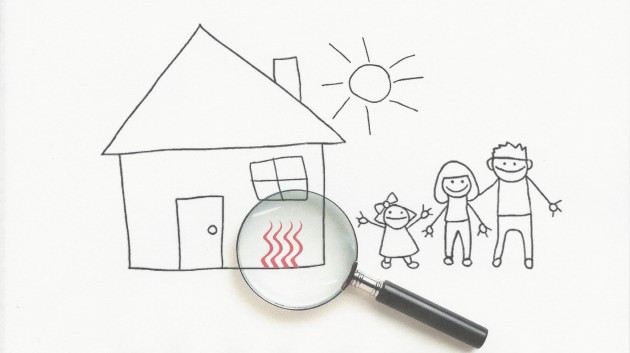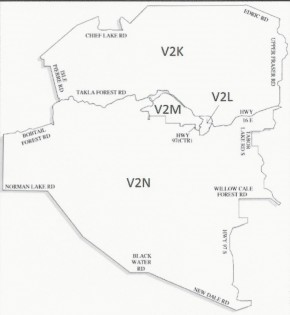Nearly 1 in 3 P.G. Homes Have High Levels of Radon
Radon test results for Prince George are in – image courtesy BC Lung Association RadonAware Project
Prince George, B.C. – Radon, a silent, colourless, odourless, gas which is created by the decay of uranium . It is considered the number 2 cause of lung cancer and it could be present in your home.
Prince George was the site of a detailed study on radon, and the results are in.
More than 2000 radon detection kits were distributed in the community to register the levels of radon in homes throughout the City.
Radon is measured in becquerels per cubic metre (Bq/m3), Health Canada recommends home radon levels not exceed a safety threshold of 200 (Bq/m3).
The Prince George test results show that of the 1,426 test kits submitted, nearly one in three registered radon above that Health Canada threshold.
The study broke down the city into four postal code areas as show on the map on the right.
Here are the results per region:
| Postal Code Area | #of homes tested | Average Bq/m3 | % of Homes Over Health Canada Action Level |
| V2K ( P.G. North) | 312 | 156 Bq/m3 | 18% |
| V2L (P.G. Central East) | 154 | 126 Bq/m3 | 14% |
| V2M (P.G.Central West) | 502 | 291 Bq/m3 | 56% |
| V2N (P.G. South) | 468 | 139 Bq/m3 | 21% |
Britt Swoveland is the Provincial RadonAware Coordinator for the BC Lung Association. She says there was no surprise as to the presence of radon in Prince George as there was some historical data to indicate there were radon issues in the community “If we look at all the tests we got back, 29% are over the Health Canada safety threshold, so certainly the message coming out of it is if folks haven’t tested their homes, they should, regardless of where they live in the community.”
The testing costs about $30 dollars . “You typically deploy (the test) for three months, up to a year because you want to capture the winter months when your home is closed up.” If your test indicates higher than acceptable levels of radon, there is a plan to fix the problem. A renovation can be done that will vent the radon through a pipe, rather than have it seep into your home. New building code regulations mean all new construction must provide for radon dispersion.
“The only way you know if you have a problem is to test for it” says Swoveland “It’s a relatively inexpensive home renovation, anywhere from $500 to $2500 dollars for the average home.” She says it’s not just an investment in your home, it’s an investment in your health.



Comments
And if the latest Comet flyby would have hit our Planet we would have more to worry about than “Radon” in our Homes, what will be the next big Scare ? Another thing to suck Money out of Home Owners.
We all will die from something, so don’t be scared, start living!
Paint your basement floors, new houses think they have addressed it but you would be surprised what trades do after inspections.
is there a difference in how your house was built that determines the levels? wood basement vs. cement basement, clay base vs. sand base etc…or should all older houses just be tested regardless. i read somewhere that if your house is built on clay there is an extremely slim chance of radon getting though…..
I really don’t think if a comet hits the planet there will be much too worry about. If your lucky, you will be incinerated with in the first couple of hours, if not you will starve to death.
I think we should be more concerned about the cleaning agents we use in our homes than Radon gas.
I think we should be more concerned about the processed foods that we eat. yummy and quick, but there has to be something nasty in there in which it can preserve the food for months.
I think we should be more concerned about the amount exercise we do. Being skinny from eating control does not mean your in good health. It is better to be a few pounds over and to have good cardio and core, than to be skinny and have pour cardio and no core.
I think having Flouride added to our drinking water is more important than radon gas.
Just by looking at the stats of the areas and knowing the different materials you can tell clay does have lower readings. The more sealed up your foundation the less gas that can infiltrate your house. Simply painting your slab works wonders, I would suggest even new house should do this because the vapor barrier has been compromised and the gas gets through.
Just spent five minutes scanning info on the net .. lots of good info available from credible sites … couple of key facts consistently jumped out …
Radon has been directly related to lung cancer second only to smoking.
Ventilation is the primary prevention and remedy for homes with high Radon levels.
Both of these facts are highlighted in the story above.
Ventilation is the primary prevention and remedy for homes with high Radon levels.—–Yes and when you install a new furnace they check your house for air leaks and try to sell you all new windows and doors because they are letting some air get into your house.
Spending a few hundred on epoxy paint for 95% reductions of gas, as opposed to hundreds of dollars each year to run this stupid system and thousands to install it…ya right.
Not advocating one way or the other, but if your home is found to have high levels of radon, simply pressurizing the house with outside air will keep it out.
Does not have to be elaborate or expensive.
A few hundred c.f.m. depending on the cubic volume of the house, and how tightly built it is. Newer homes that do not leak much are probably part of the problem, not enough air changes. Conversely, newer homes are easier to pressurise.
You are talking about a fractional h.p. electric motor
running year round, costing pennies per day.
metalman.
So, if we don’t want radon killing us, I guess it is best to have a window open at all times, if possible. Well, then we have a terrible pollution stink to kill us though…..better move to the country.
There’s been a lot of “hype” about Radon over the last 10 years or so, and I’m not entirely convinced about the degree of risk presented by exposure to low levels of radon – and even a level of 291 Bq/M3 wouldn’t be considered high – it’s higher than the recommended concentration, but it’s not high when you look at the exposure and cancer data. I know 291 Bq/M3 is an average and it would have been useful to know the range of concentrations found. In the US 21,000 deaths from lung cancer attributable to radon every year – out of a total of about 257,000 lung cancer deaths per year – that’s about 8%. it might be the second highest cause but it’s a distant second. I’m also concerned about the accuracy of the measurement techniques – reports show that they can be measuring 40% low. And I always get nervous when there’s just ONE sample taken at any given location especially when people suggest costly “repairs” based on those single samples.
I fully agree with akanemo
I did the Radon test in my house last winter. Came back around 280
I also attended an info session about Radon at the Alward Street Cancer Lodge. I do not trust the one-time test results to be accurate. I would not spend thousands of dollars on remedial work based on that test. Apparently there is only one company in town at the moment who is qualified to do the remedial work, therefore no second opinion being offered. The other catch is, this info, reliable or not, may affect the re-sale value of your house.
I have more fear of getting Cancer from the food I am consuming than the place I dwell.
It would have been useful if they had asked those people who tested their houses, how long they had been living there, and how many people in the house actually ended up with lung cancer.
That way we could have had some good statistics,.
Ie; V2M PG Central West.
Number of homes tested…………502
Average bq/m3…………………291
% of homes over health Cda
Action level…………………..56%
Number of years is house…………???
Number of people who developed
lung cancer…………………….???
Using this model we would know pretty well exactly how many people actually developed lung cancer from radon gas.
Wonder why they didn’t ask the question.
Comments for this article are closed.